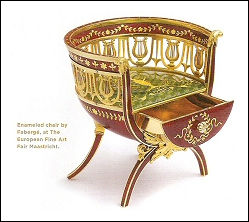February 2008
Fabergé Objects on the Market

Enameled Chair by Fabergé will be exhibited
by Wartski of London at The European Fine Art
Fair in Maastricht, The Netherlands,
March 3-16, 2008.
(Courtesy TEFAF Maastricht)

Alexander III 25th Wedding Anniversary
Presentation Desk Clock – Winter 2008 issue
of Heritage Magazine for the Intelligent
Collector includes an interview with the
owner of this clock. Marie Betteley, Fabergé
and Russian art expert and gemologist, is the
consultant on The James C. Russo Collection
of Royal Artifacts. Signature Auction #5003
on April 24, 2008 Heritage Auction Galleries.
(Courtesy Heritage Auctions)
Readers Forum
- A user of the research tool, Russian Antique Silver – Hallmarks of Silversmiths – Russian Maker’s Marks by Giorgio B., suggests that errors are sometimes created between Cyrillic and Latin transcriptions, and other oddities appear in dealing with hallmarks and makers marks. The reviewer’s advice is to appreciate the large volume accumulated in this reference tool, but to continue learning more and more, and to read with a “critical eye”.
- A presentation box shown at the Horseguard Museum in London has been attributed to the English firm of Wright and Davis and is not by Fabergé as stated on the museum’s web page.
- Is there any further news about the missing stand of three silver putti sitting in a grassy mount on a circular, jadeite base supporting the Diamond Trellis egg sold at Sotheby’s London, December 5, 1960? The reader states the stand had an English hallmark from 1908. Could it be because Maria Fedorovna went to see her relatives in London in 1908 and – by mistake – her Egg was stamped together with all the other Fabergé objects?
- Readers are asked to review the list of audio and video tapes listed in Audio-Visuals of the Fabergé Research Site, and share the details of any oversights with the Editor of this newsletter. Especially needed are listings of dvds.
Fauxbergé
- A reader writes: Modern Fabergé objects are just modern pieces, but fakes are not acceptable … an active Fake/Spurious Fabergé Discussion Forum exists.
- A reader contacted a California museum, which was about to open an exhibition showing an egg alleged to be by Fabergé. After a thorough authentication process by the museum staff and Fabergé scholars the object was withdrawn from the exhibition. The same reader advises “he has been tracking similar eggs from this Bulgarian dealer on ebay for several years … So far we have uncovered two ‘Imperial Eggs’ that he has sold in just the last month!” His concern is that this kind of merchandise will be sold to other unsuspecting persons and infiltrate museums.
Readers are alerted to the following terminology used by Christie’s auction house for authentication:
- “Marked Fabergé, Workmaster …” In our opinion, a work of the master’s workshop inscribed with his name or initials and his workmaster’s initials.
- “By Fabergé …” In our opinion, a work of the master’s workshop, but without his mark.
- “In the style of …” In our opinion, a work of the period of the master and closely related to his style.
- “Bearing marks …” In our opinion not a work of the master’s workshop and bearing later marks.
- Scholarly publications discussing genuine Fabergé marks and hallmarks are included in the Fabergé Eggs: A Retrospective Encyclopedia, pp. 175-245.
Readers of this newsletter are invited to share information about Fabergé happenings worldwide.
